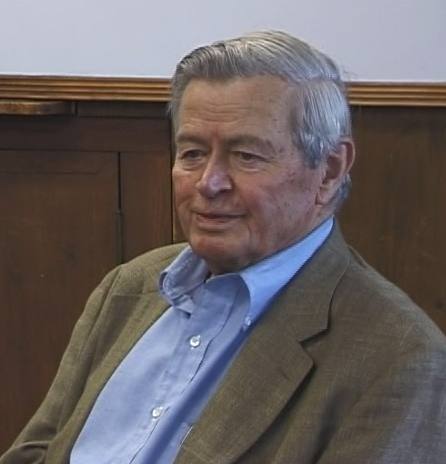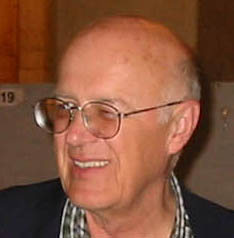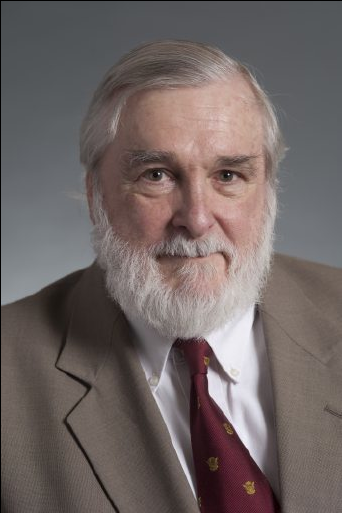|
|
"As you obsolesce as a scientist, if you live long enough, you turn into a historian. I guess that's what's happened to me.", Arnold Arons, Oct. 2000, WHOI Ocean Acoustics Lab. Presented here are talks by prominent acousticians and pioneers in engineering and science who have visited the Ocean Acoustics and Signals Lab at WHOI. Transcriptions and audio/video of most of the talks can be downloaded and/or viewed below. They are also available by request from the WHOI archives. Arnold Arons
 Arnold Arons ( November 23, 1916 - February 28, 2001) Arnold Arons was widely regarded as one of the leaders in physics and in physics education. He received his PhD in physical chemistry in 1943 from Harvard University. World War II brought Prof. Arons to the Woods Hole Oceanographic Institution, where he was a group leader in the Underwater Explosion Research Laboratory. He is well known for his studies here at WHOI of abyssal oceanic circulation and cloud physics and for experimental and theoretical work on phase distortion of acoustic pulses reflected from the seabed. From 1946 on, he taught at Stevens Institute of Technology, Amherst College, and University of Washington. In these years he revitalized the traditional physics of the time with his teaching techniques and numerous articles and books. His acomplishments included him in a TIME magazine story on education. Prof. Arons also served on many committees, including the NSF commission of college physics, as a trustee of the Woods Hole Oceanographic Institution and the American Institute of Physics. Prof. Arons passed on February 28, 2001 at his Seattle home. OASL Seminar 10/11/2000 audio (which is also video streamed). A transcription of the seminar may help folowing along with the audio. Prof. Arons also sent a followup email to clarify one of his points from the seminar.
Robert A. Frosch Robert Frosch Robert Frosch received his undergraduate and graduate degrees in theoretical physics at Columbia and received his Ph.D. at the young age of 23. After that, he advanced at Hudson Laboratories to Director of Research, where he was a project manager of ARTEMIS, which developed active sonar for the Navy. In September 1963, he went to Washington DC to work with the Advanced Research Projects Agency in the US Department of Defense, serving as Director for Nuclear Test Detection and as the authority for the program of research and development as deputy director of the Advanced Research Projects Agency. Frosch moved on to become Assistant Secretary of the Navy and was in charge of all the research and development at the US Navy. Later, he became Assistant Executive Director of the United Nations Enviromental Program and then went on to NASA, where Bob Frosch was the 5th administrator. In January 1981 he moved to General Motors where he was appointed Vice President of Research and Development in research labs. He is still active in both scientific and technical policy activities today and is a guest investigator in the Ocean Acoustics and Signals Lab at WHOI. AOPE Seminar 7/11/07 video and Transcription AOPE Seminar 4/07/08 video Peter Westervelt Peter Westervelt Peter Westervelt is a physicist who has made great contributions to the field of acoustics. His application of the theory of Sir James Lighthill contributed to understanding absorption of sound by sound and nonlinear-scattering of sound by sound. He also discovered and explained the principles of the parametric array. During his career, he was responsible for work with the National Academy of Sciences and the National Research Council and was elected to be Fellow of the American Physical Society, the Acoustical Society of America, and the American Astronomical Society. Westervelt was also Assistant Attache for Research in the U.S. Navy, served at the American Embassy in London and as Consultant to Bolt, Beranek, and Newman, along with making breakthroughs at the University of Texas at Austin on new techniques and applications on the study of sound by sound scattering. Lastly, he is a Professor Emeritus at the Brown University Physics Department and is still sharing his vast knowledge and lively stories today. OASL Seminar 11/15/06 video and transcription are available.
Stan Ehrlich Stan Ehrlich January 7, 1925 - July 24, 2013. Stan Ehrlich is a graduate of Brown University, with both bachelors and masters degrees. He worked for Raytheon Company Submarine Signal Division for most of his career, eventually advancing to the rank of fellow. He has a long involvement in the Acoustical Society of America (ASA), serving as President from 1996-1997. He has distinguished himself professionally by his engineering work on sonar arrays and acoustical standards, among other things. Stan received the Mira Paul Memorial Award in 2002, given by the Acoustical Foundation, Educational, and Charitable Trust (AFECT), an Indian organization, with programs to help deafened individuals, for his contribution to the founding the first International Chapter of the ASA in India and the Acoustical Foundation of India. His name also adorns an award, the Stanley Ehrlich Gold Medal presented by AFECT to an eminent acoustician or surgeon, irrespective of nationality, age, or society affiliation to promote international brotherhood in the diverse field of acoustics. OASL Seminar 11/5/08 video and transcription are available. Stanley Ehrlich obituary in 'Acoustics Today, October 2013' Allan D. Pierce Allan D. Pierce Allan Pierce is known for a large variety of fundamental research on the mechanics of waves, acoustics, and structural vibrations. His landmark book, Acoustics: An Introduction to its Physical Principles and Applications, is widely considered the definitive acoustics textbook. He is the Editor-in-Chief of the Acoustical Society of America and past co-editor of the Academic Press series on Physical Acoustics and of the Journal of Computational Acoustics. Dr. Pierce has received the Silver Medal in Physical Acoustics, the Rossing Medal for Acoustics Education, the Gold Medal of the Acoustical Society of America, the Per Bruel Gold Medal of the American Society of Mechanical Engineers, the Gold Medal of AFECT (Acoustical Foundation, Educational, and Charitable Trust), and the Alexander von Humboldt Foundation Senior U.S. Scientist Award. Dr. Pierce is currently a Professor of Mechanical Engineering at Boston University and was Department Chair from 1993 to 1999. Prior to that, at Penn State Dr. Pierce held the Leonhard Chair in Engineering and previously at Georgia Tech he was Regents Professor. He is also an Adjunct Scientist at WHOI. Allan's AOPE Seminar presentation, titled "Low Frequency Behavior of Sandy and Muddy Sediments" on Jan 5 2011, is available as a video . Allan's life and career in his own words is available on video in a talk he gave to the WHOI Ocean Acoustics and Signals Lab on Aug 7th, 2013. Bill Carey Bill Carey March 3, 1943 - July 11, 2012 The WHOI AOPE video mentioned below was Bill's last public appearance. Bill Carey's research was focused on the use of autonomous array systems and array signal processing to perform measurements of the acoustical properties of the oceanic coastal margins. Dr. Carey received a bachelor's degree in mechanical engineering, a master's degree in physics, and a PhD in nuclear science from The Catholic University of America. Most recently, he was a professor of mechanical engineering at Boston University, an adjunct professor of applied mathematics at the Rensselaer Polytechnic Institute, and an adjunct scientist in applied ocean physics and engineering at the Woods Hole Oceanographic Institution. He was the editor emeritus of the Journal of Oceanic Engineering and an associate editor for the Journal of the Acoustical Society. Earlier in his career, Dr. Carey served as a physicist with the Naval Undersea Warfare Center and the Advanced Research Projects Agency assigned to the MIT Department of Ocean Engineering, where he taught graduate courses in acoustics. He was also a research physicist and engineer at the Naval Underwater Systems Center, The Naval Oceanographic Research and Development Activity, and at the Naval Research Laboratory. He was a consultant to both industry and government in the areas of nondestructive testing, nuclear science/environmental measurements, and applied ocean acoustics.
Dr. Carey was a Fellow of the Institute of Electrical and Electronics Engineering (IEEE)-Oceanic Engineering Society and received the Society's Distinguished Technical Achievement Award, Distinguished Service Award, and Third Millennium Award. In 2007, the Acoustical Society of America awarded Dr. Carey the Pioneer of Underwater Acoustics Silver Medal. At the time, only 16 other individuals had earned this distinction since the medal was introduced in 1959. Dr. Carey was a Fellow of the Acoustical Society of America, a member of the Connecticut Academy of Science and Engineering, Sigma Xi, and the Cosmos Club.
Doug Webb Doug Webb Doug Webb has made numerous contributions to the study of the ocean and of ocean acoustics. He received his Masters degree in Electrical Engineering in 1954 from Manchester University, where he built and programmed the first transistor computer. In 1962 Doug joined WHOI and developed the SOFAR Float, a technology used to map deep ocean currents. After retiring in 1982, Doug founded the Webb Research Corporation, where he developed and manufactures specialized instruments used in ocean research such as the Slocum Glider and the Sea Glider. He has recieved numerous awards, including the Institute of Electrical and Electronic Engineering's Distinguished Technical Achievement Award in 2005 and WHOI's Henry Bryant Bigelow Award in Oceanography in 1988. OASL Seminar 4/13/11 video and transcription are available.
Ivan Tolstoy and Clarence S. Clay Jr.

Ivan Tolstoy and Clarence Clay Although Dr. Ivan Tolstoy wasn't here at WHOI while making this video, his work and books with Clarence S. Clay Jr. are an important presence in our research and library. Their work will be continually referenced in most acoustics research journals and we are proud to know both as colleagues and friends.
You may view a video Dr. Tolstoy made for the Acoustical
Society of America Meeting in Kansas City, Nov. 2012, in celebration and rememberance of his co-author and friend Clarence Clay (1921-2012). Video courtesy of the Acoustical Society of America.
Last updated: July 14, 2017 |
|||||||||||||||||
Copyright ©2007 Woods Hole Oceanographic Institution, All Rights Reserved,
Privacy Policy. |

